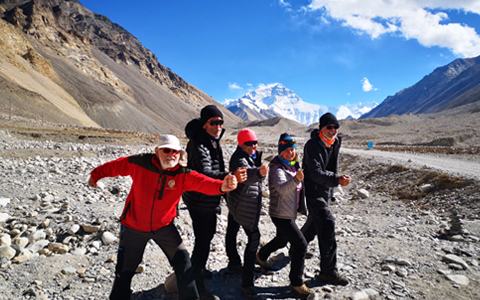In Tibetan Buddhism, all mountains are considered holy. Among them, some mountains hold special reverence, such as Mount Kailash, Mount Everest and Mount Namjagbarwa. If you are seeking a spiritual tour to Tibet, don’t miss this guide on Tibet’s 8 most sacred mountains.
All of these eight holy mountains are accessible, and one of them can even be touched. And most mountains are circled clockwise during a kora. For more details and inspiration, read on and choose one mountain for your lifetime pilgrimage journey!
1. Mount Kailash (6638m): The Most Sacred Mountain in Four Religions
Without a doubt, Mount Kailash is the most sacred mountain you should not miss in Tibet. Also known as Mount Gang Rinpoche, it is considered to be the most revered mountain in Tibetan Buddhism, and the “center of the universe” in four religions - Hinduism, Buddhism, Jainism, and Bon.
Located in Ngari Prefecture of western Tibet, Mount Kailash is about 1600 kilometers from Lhasa. For most tourists, you will need at least four days of driving to get to the mountain. While for Tibetan pilgrims on their sacred pilgrimage, this trip can take months.
A highlight of visiting Mount Kailash is completing the kora, which is believed to cleanse sins and bring spiritual enlightenment. Also one of Tibet’s best treks, the Mount Kailash kora trek usually takes 3 days, covering a distance of around 52 kilometers. During the kora, you may even have a chance to touch the rock face of Mount Kailash.
To make the most of your journey, we recommend joining our classic 15-day Lhasa to Mount Kailash tour. Taking this tour, you will not only experience the 3-day kora accompanied by our experienced local guide, and also visit other famous Tibet attractions like Potala Palace and Everest Base Camp.
The best time to visit Mount Kailash is between April and October, when the weather is milder and the scenery is stunning. In winter months, the mountain might be inaccessible due to the heavy snow. So it is important to plan your trip accordingly.
 Mount Kailash is most sacred mountain in Tibet.
Mount Kailash is most sacred mountain in Tibet.This is our most popular Mount Kailash small group tour.
2. Mount Everest (8848m): “Goddess Mother of the World”
Mount Everest, the highest peak in the world, is known as "Chomolungma" in Tibetan, meaning “Goddess Mother of the World.” It is not only one of the most famous attractions in the world, but also holds deep spiritual significance for Tibetan Buddhists.
Located on the border between Tibet and Nepal, Mount Everest has a base camp in each side. The North Base Camp in Tibetan side is much easier to reach, thanks to a well-paved asphalt road extending directly from Lhasa. It also offers a closer and unobstructed view of Mount Everest.
Near the Everest Base Camp in Tibetan side, you will also find Rongbuk Monastery, the world’s highest temple. This sacred monastery is not only a perfect site to view stunning Mount Everest, but also offers a guesthouse for overnight stay for tourists.
Luckily, you can visit Everest Base Camp in Tibet throughout the year. And the best way is to join our 8-day Lhasa to Everest Base Camp tour, which covers all the essential highlights of Tibet. In addition to the breathtaking views at the base camp itself, you will also have chances to admire Mount Everest from several viewpoints along the way.
 A glorious view of Mount Everest in Tibetan side
A glorious view of Mount Everest in Tibetan sideJoin our most popular Mount Everest small group tour for the best experience
3. Mount Namche Barwa (7782m): “Father of Tibetan Mountains”
The highest mountain in Nyingchi Prefecture of the Tibet Autonomous Region, Mount Namche Barwa is revered as the "Father of Tibetan Mountains." It is also considered to be one of the most beautiful snow-capped mountains in China.
Soaring 7,782 meters into the air, the mountain’s peak is often shrouded in clouds, adding to its mysterious allure. It is said that the summit is a place where the gods gather for their ritual ceremonies, and that a divine temple with a pathway to the heavens once existed on the summit.
If you are planning a trip to Mount Namche Barwa, you should not miss our Nyingchi tours, which also allow you to visit other popular attractions of the region, like Basom tso Lake. When you travel overland from Chengdu to Lhasa, you will also have a chance to see this holy mountain.
The best time to visit Nyingchi is from April to June and September to early November, when the weather are at their finest. Summer can be wetter in Nyingchi, owing to the monsoon rains. While winters can be chilly, they are still warm enough for a visit.
 Mount Namjagbarwa is one of the most beautiful snow-capped mountains in China.
Mount Namjagbarwa is one of the most beautiful snow-capped mountains in China.4. Mount Bonri (4500m): Sacred Mountain of Tibetan Bon Religion
Located in the Bayi District of Nyingchi County, Mount Bonri is one of the most sacred mountains worshiped by the Bon believers. It is said to be the only mountain in the world that was personally blessed by Tonpa Shenrab Miwoche, the founder of the Bon religion.
Every year, many pilgrims come to do the kora around the mountain, in order to eliminate sins and seek blessings. If you want to visit this holy mountain, you can easily drive there from Nyingchi city, which takes only about 50 minutes. Just remember to circle anticlockwise when you kora around the mountain.
 Kora around Mount Bonri follows the anticlockwise direction.
Kora around Mount Bonri follows the anticlockwise direction.5. Mount Nyenchen Tanglha (7162m): Holy Mountain Near Namtso Lake
Rising to 7162 meters, Mount Nyenchen Tanglha is the main peak of the Nyenchen Tanglha Mountains, and lies next to Namtso Lake, one of Tibet’s “Top Three Holy Lakes”. In Tibetan mythology, the mountain and the lake are seen as a divine couple, harmoniously connecting each other.
Every year, many tourists are attracted to this sacred region to admire the snow-capped peaks and clear lake waters. In addition to enjoying the stunning scenery, you can also trek around Namtso Lake, following the footsteps of devoted pilgrims.
It’s easy to travel from Lhasa to Namtso Lake and Mount Nyenchen Tanglha, and you can include the trip in a 6-day tour that also covers sightseeing in Lhasa. The best time to visit is between May to October, when the weather is mild and the scenery is particularly charming.
 Breathtaking Namtso Lake and Mount Nyenchen Tanglha in the distance
Breathtaking Namtso Lake and Mount Nyenchen Tanglha in the distanceDon't miss our classic EBC and Namtso tour to visit the best of Tibet.
6. Mount Tsari (5722m): One of the 24 Sacred Mountains in Tibetan Folklore
Mount Tsari, located in southeastern Tibet, is one of the 24 sacred mountains revered in Tibetan folklore. It is considered the ideal "Palace of Chakrasamvara" in Buddhist belief. Many saints, including Guru Rinpoche and Tsongkhapa, are said to have practiced here and attained enlightenment.
Compared to other holy mountains in Tibet, Mount Tsari is relatively isolated. To get there, you need to first travel to Tsari Township from Lhasa via Tsedang in Shannan. The whole journey covers 500 kilometers, and an SUV is required to handle the rough roads.
 Mount Tsari is one of the 24 sacred mountains revered in Tibetan folklore.
Mount Tsari is one of the 24 sacred mountains revered in Tibetan folklore.7. Mount Meili Snow (6740m): The Holy Mountain in Yunnan Diqing Tibetan Area
Situated on the border between the Tibetan Autonomous Region and Yunnan Province, Mount Meili Snow Mountain is one of the “Eight Divine Mountains of Tibetan Buddhism”. It is indeed a small multi-peaked range with the highest peak being Mount Kagebo, at 6,740 meters above sea level.
The most stunning highlight of Mount Meili Snow is its golden peak during sunrise, which is extremely spectacular and usually only occurs in the early morning on a sunny day. Wunongding and Feilai Temple are the best places to watch and photograph this awe-inspiring view.
If you take an overland tour from Yunnan to Tibet, you will have the chance to admire the Mount Meili Snow along the way. The trip typically starts in Lijiang and ends in Lhasa, allowing you to visit many other famous attractions in both Yunnan and Tibet.
 The best view of Mount Meili Snow can be seen from Feilai Temple.
The best view of Mount Meili Snow can be seen from Feilai Temple.8. Mount Amne Machin (6282m): The Holy Mountain in Qinghai Golog Tibetan Area
Located in the Golog Tibetan Autonomous Prefecture of Qinghai Province, Mount Amne Machin means “Grandfather Pomra” in Tibetan. It is revered as the home of Machen Pomra, the chief indigenous deity of Amdo.
The entire mountain range forms the middle branch of the eastern section of the Kunlun Mountains. The main peak shares the same name and stands 6,282 meters above sea level, being snow-covered all year round, with many glaciers flowing from it.
Many pilgrims perform a kora around the mountain, and the journey can take seven to eight days to complete. The mountain’s natural beauty also attracts many adventurers seeking an unforgettable experience.
 The Holy Mountain in Qinghai Golog Tibetan Area - Mount Amne Machin
The Holy Mountain in Qinghai Golog Tibetan Area - Mount Amne MachinOur Mount Kailash tour offers a lifetime spiritual journey with quality service.
Dos and Don’ts When Visiting These Scared Mountains in Tibet
When visiting Tibet’s sacred mountains, it is essential to show your respect, and adhere to local culture and customs.
Avoid climbing mountains that are off-limits for religious reason, such as Mount Kailash. Always seek permission from local communities or religious authorities, if you wish to take some activities in the mountain areas.
Remember to walk clockwise around the mountains revered by Tibetan Buddhists, like Mount Kailash and Mount Meili Snow. However, when kora around mountains sacred to the Bon religion, like Mount Bonri, walk counterclockwise.
Protect the environment and pristine beauty of these mountains. Do not litter; leave no trace. Bring plastic bags to collect your waste when visiting remote mountains during your Tibet tour.
Conclusion
The mountains in Tibet are not only natural wonders but also spiritual symbols revered by thousands of pilgrims. Whether you are seeking a spiritual journey, a trekking adventure, or just admiring the breathtaking scenery, these mountains offer you an unforgettable experience in Tibet. If you have more questions about traveling in Tibet, feel free to contact us or book your tour with us today.

























 Mount Kailash is most sacred mountain in Tibet.
Mount Kailash is most sacred mountain in Tibet.
 A glorious view of Mount Everest in Tibetan side
A glorious view of Mount Everest in Tibetan side
 Mount Namjagbarwa is one of the most beautiful snow-capped mountains in China.
Mount Namjagbarwa is one of the most beautiful snow-capped mountains in China. Kora around Mount Bonri follows the anticlockwise direction.
Kora around Mount Bonri follows the anticlockwise direction. Breathtaking Namtso Lake and Mount Nyenchen Tanglha in the distance
Breathtaking Namtso Lake and Mount Nyenchen Tanglha in the distance
 Mount Tsari is one of the 24 sacred mountains revered in Tibetan folklore.
Mount Tsari is one of the 24 sacred mountains revered in Tibetan folklore. The best view of Mount Meili Snow can be seen from Feilai Temple.
The best view of Mount Meili Snow can be seen from Feilai Temple. The Holy Mountain in Qinghai Golog Tibetan Area - Mount Amne Machin
The Holy Mountain in Qinghai Golog Tibetan Area - Mount Amne Machin









Ask a Quick Question